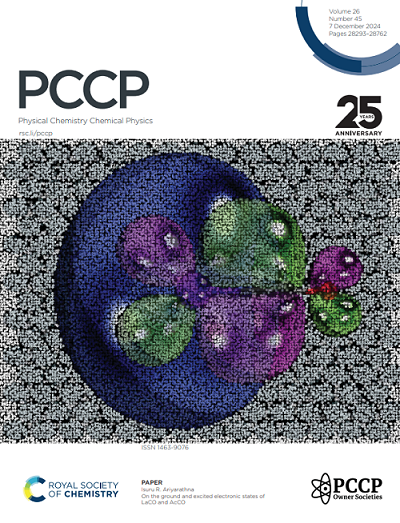具有塑性晶相的N,N-二乙基吡咯吡啶双(氟磺酰基)酰胺的相行为与重定向和转理动力学关系的核磁共振研究
IF 2.9
3区 化学
Q3 CHEMISTRY, PHYSICAL
引用次数: 0
摘要
利用低频脉冲核磁共振技术测量了N,N-二乙基吡咯吡啶二(氟磺酰基)酰胺的自旋-晶格弛豫时间(T1)和自旋-自旋弛豫时间(T2)在1H和19F的温度依赖性,研究了N,N-二乙基吡啶二(氟磺酰基)酰胺有序晶体、塑料晶体(PC)和液相之间的相变动力学。T1和T2分别对离子的重定向和平移动力学敏感。由于H和F原子分别只存在于正离子和阴离子中,所以它们的动力学行为可以分别研究。PC和液相1H(或19F)温度相关T1曲线在熔点处平滑连接,表明两相中阳离子(或阴离子)的旋转运动相似。在PC相中,1H和19F均观察到不同的T2组分,反映了阳离子和阴离子协同平移运动的非均质动力学。这些动力学归因于每个PC晶体内的核心和表面相的存在。在熔点处,表面相的T2值平稳地转变为液相的T2值。本文章由计算机程序翻译,如有差异,请以英文原文为准。

Nuclear magnetic resonance study of the relationship between phase behaviour and reorientational and transrational dynamics in N,N-diethylpyrrolidinium bis(fluorosulfonyl)amide with a plastic crystal phase
We investigated the phase transition dynamics between the ordered crystal, plastic crystal (PC), and liquid phases of N,N-diethylpyrrolidinium bis(fluorosulfonyl)amide by measuring the temperature dependences of spin–lattice relaxation time (T1) and spin–spin relaxation time (T2) for 1H and 19F using low-frequency pulsed nuclear magnetic resonance. T1 and T2 are sensitive to the reorientational and translational dynamics of ions, respectively. Because H and F atoms are exclusively present in the cation and anion, respectively, their dynamic behaviours can be investigated separately. The temperature-dependent T1 curves for 1H (or 19F) in the PC and liquid phases were smoothly connected at the melting point, indicating similar rotational motions for the cations (or anions) in both phases. In the PC phase, distinct T2 components were observed for both 1H and 19F, reflecting heterogeneous dynamics due to cooperative translational motion of the cations and anions. These dynamics are attributed to the presence of core and surface phases within each PC crystallite. At the melting point, the T2 values of the surface phase transitioned smoothly to those of the liquid phase.
求助全文
通过发布文献求助,成功后即可免费获取论文全文。
去求助
来源期刊

Physical Chemistry Chemical Physics
化学-物理:原子、分子和化学物理
CiteScore
5.50
自引率
9.10%
发文量
2675
审稿时长
2.0 months
期刊介绍:
Physical Chemistry Chemical Physics (PCCP) is an international journal co-owned by 19 physical chemistry and physics societies from around the world. This journal publishes original, cutting-edge research in physical chemistry, chemical physics and biophysical chemistry. To be suitable for publication in PCCP, articles must include significant innovation and/or insight into physical chemistry; this is the most important criterion that reviewers and Editors will judge against when evaluating submissions.
The journal has a broad scope and welcomes contributions spanning experiment, theory, computation and data science. Topical coverage includes spectroscopy, dynamics, kinetics, statistical mechanics, thermodynamics, electrochemistry, catalysis, surface science, quantum mechanics, quantum computing and machine learning. Interdisciplinary research areas such as polymers and soft matter, materials, nanoscience, energy, surfaces/interfaces, and biophysical chemistry are welcomed if they demonstrate significant innovation and/or insight into physical chemistry. Joined experimental/theoretical studies are particularly appreciated when complementary and based on up-to-date approaches.
 求助内容:
求助内容: 应助结果提醒方式:
应助结果提醒方式:


